Yamaha’s Fazer 1000 was supposed to be THE naked litre-class bike, but strange pricing and fierce competition meant things didn’t go to plan. Andy Bolas rides the Fazer and finds its future as a classic is as bright as its paintwork.

Words: Andy Bolas, Bertie Simmonds Pics: Gary Chapman, Mortons Archive
Back in 2001 Yamaha were riding high on the success of their YZF-R range which included the now iconic R1 and R6, and were also following the trend of making naked versions of their sports machines.
These were bikes with more practicality, less pose and a bit less speed. The blueprint came first for Yamaha with 1998’s FZS600 Fazer – not powered by the R6 motor, I’ll grant you. Instead it used the punchy and beautifully-carburated four-cylinder motor from the previous 600 sports machine, the YZF600 Thundercat. It made sense then that at some point, either a 1002cc Thunderace motor or perhaps the 998cc YZF-R1 motor could be a good starting point for a big naked Yamaha.
Eventually, the news broke in 2000 that (for the 2001 model year) a FZS1000 Fazer would be produced, using the R1 motor in a street bike chassis, using a Fazer 600-esque tubular frame, complete with a comfy riding position and handlebars instead of clip-ons.
When the first pictures emerged, it was obvious that the Fazer 1000 was styled a lot sharper than its smaller sibling – but soon the 600 would also ape it’s bigger brother’s cooler aesthetics. What would be almost identical though, was the whole ‘ethos’ of both bikes. They would be used for everything from touring to track-days, commuting and everything in between. Fazers really did become the Swiss Army Knife of the motorcycle world… Today, they’re both now in the realm of the modern classic, being more than 20 years old. Which means that these little (and not so little) gems can also be covered with classic insurance – and all for a brilliant bike that can cost just a couple of grand these days.
Let’s look at the FZS Fazer 1000 then. The powerplant is the five-valves per pot unit taken straight from the first generation R1 but then slightly detuned for more mid-range, which involved a heavier crankshaft (by some 10 per cent) which stops the motor spinning up so quickly calming the power delivery down; compression ratio was also down a smidge. Next up are the carb. The R1 uses down-draught carbs like most super-bikes, but these would cause issues with having a decent size fuel tank so were dropped in favour of side-draught carbs which, at 37mm, were 3mm smaller than the 40mm items on the original R1 motor.
The end result was a meaty mid-range and a claimed power of 143bhp, not too far away from the claimed poke of the R1 it came from, which was in the 150-155bhp bracket.
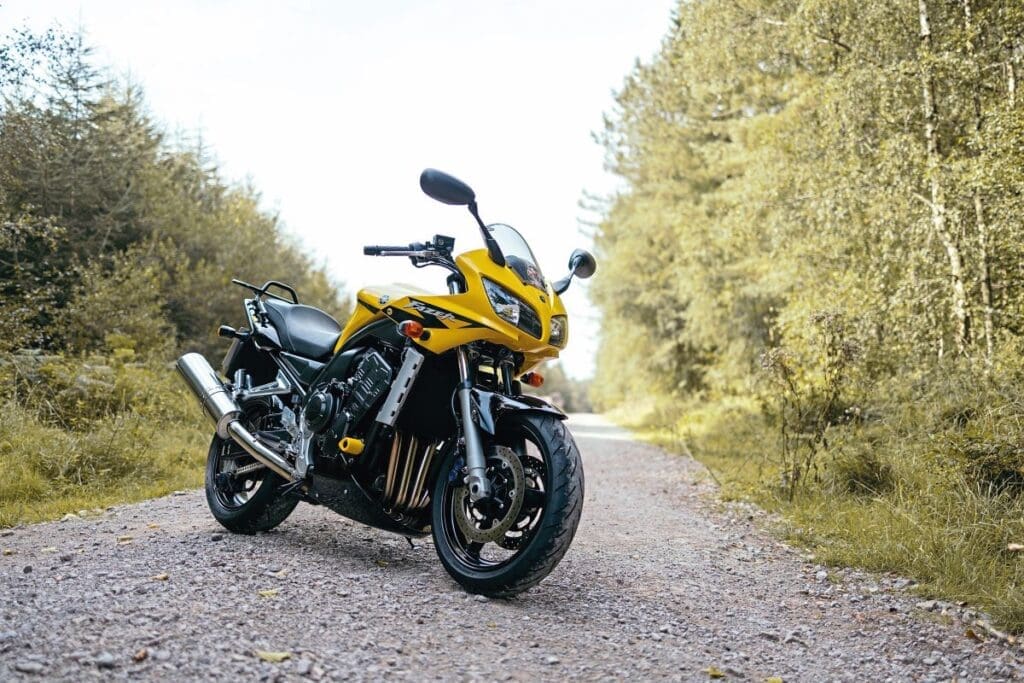
When the bike was released some of the road testers at the time thought that Yamaha had gone a little too far and had calmed the power delivery down too much; peak output at the rear tyre was reported to be around 120-125bhp. Personally, I think it is great for both mile-munching and blasting down the A and B roads; it’s a gutsy motor. And it’s all held in check by that big tubular double-cradle steel frame.
The riding position and 21 litre fuel tank mean you can smash long distances without too much bother, although I did have a few issues with the position of the handlebars and ended up rotating them back towards the tank, which ended the uncomfortableness for me – let’s see if Bertie notices! Considering this class of bike was reinvented by the Bandit 1200 (or was it the Yamaha Diversion 900?) Yamaha must have missed the memo regarding the bikes being built to a budget as the finish on the Fazer was far superior to the Bandit although so was the price when released: the Fazer was £8099 so not such a budget street bike – but more on that from Bertie…
The curious case of Fazer 1000 pricing!
Where the Fazer 6 was priced competitively and not seen as anything other than what it was – a brilliantly-specc’d middleweight naked that had the beating of both the Hornet and the Bandit – the Fazer 1000 was something different.
Yamaha said on launch of the Fazer 1000 during 2001 that this was an ‘alternative sports-bike’ and that it would be priced accordingly at £7799 or more than £8000 with the ‘on-the-road’ costs. As a comparison, the then-new for 2001 GSF1200 Bandit was around £5999, the Honda X-11 £6950, their Hornet 900 was around £6300 and the Kawasaki ZRX1200R £6395.
Things changed quickly with a reprice to £6999 for the Fazer 1000 in 2002 (£7234 OTR). There was no admission of guilt. Yamaha’s press officer of the time was full of spin about why the price changed, but the price change reflected that they were wrong anyways. Finally we could see the bike for what it wa: a naked 1000, not some sports-bike alternative and it was hard seeing beyond the huge mark-up over the ‘competition’.
Today with hindsight we can see what we were getting for the extra money. As Andy says, the finish was superb for the time – which makes it a great classic buy today, or workhorse. Take yer pick.
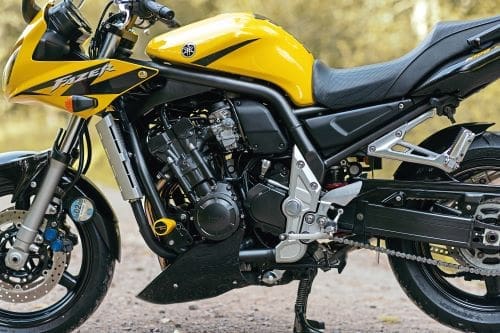

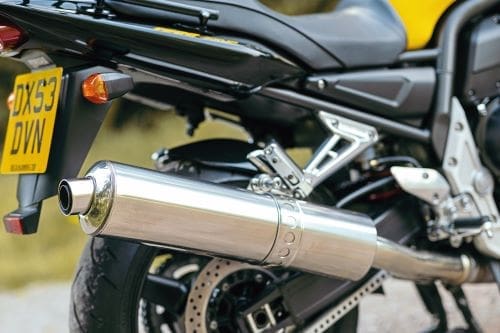
Unlike some of the other offerings in the class and in the naked middleweight class, the Fazer 1000 also featured multi-adjustable 43mm RWU forks and a multi-adjustable rear shock. However, while this sounds all well and good on paper, out on the road the front-end feels very vague and the rear feels both under-sprung and under-damped and to be fair to the bike, this is probably its only real weakness but nothing spending a couple of quid on some suspension work couldn’t cure. Oh and, of course, there’s the usual risk of the EXUP valve sticking due to lack of maintenance.
The braking set up also is taken from the R1; the famed ‘blue-spot’ Sumitomo calipers which (back in the late 1990s/early Noughties) were a by-word for braking power. On the Fazer 1000, the system used pads with a softer compound and they were (and still are) very good compared to almost everything else that was knocking around at the time. If you keep ’em clean and maintained, they are still a really good set up now, more than 20 years on…
Equipment on the Fazer is also of a very good standard: the clocks are easy to read; the fuel gauge is very accurate; and you’ve even got a digital clock, which was only just starting to become the norm back then, thanks to clocks with lots of LCD displays. Remember how we’d glue old Casio watches to the top yoke or on the dash? At speed, that attractive little half-fairing does a stand-up job of keeping the wind-blast away from you and at night the headlight clusters work well. Dipped has a good, wide spread and main beam really lights up the road ahead when there’s no oncoming traffic to dazzle. For practicality’s sake, you’ve got a space for a decent-sized U-lock under the (quite comfy) seat and the centre-stand takes the pain out of lubing and adjusting the chain.
When released, the Fazer’s competition came from the long-in-the-tooth Suzuki GSF1200 Bandit, which was in its Mk.2 guise and had become a trifle dull in comparison to the original head-banging budget bike. This, coupled with the very poor build quality, didn’t help the Suzuki’s case, even at £2500 less than the Yamaha. Honda’s CBF900 Hornet was a great all-rounder and with a detuned FireBlade motor hanging under a modified Hornet 600 spine frame, could have been a Fazer-beater. Sadly it lacked a few creature comforts, such as a screen, the cockpit was basic, and it also had fewer gee-gees under the bonnet. It was a looker, though…
Of course, by 2003 (when this very bike came out) the Fazer also had the Aprilia Tuono as a bit of a competitor coming in from left-field. This used the 998cc 60-degree V-twin pumping out a claimed 114bhp and weighed around 27kg less than the Fazer. Okay, Noale’s naked is more of the hooligan’s choice compared to the safe pair of hands that is the Fazer, which makes me think… I kind of see the Fazer 1000 like a half-faired VFR800 (minus the V4 howl, of course…). I think that because the Fazer does everything so well but doesn’t really excel at any one task – but don’t let that put you off. In fact, it made the VFR series very popular.
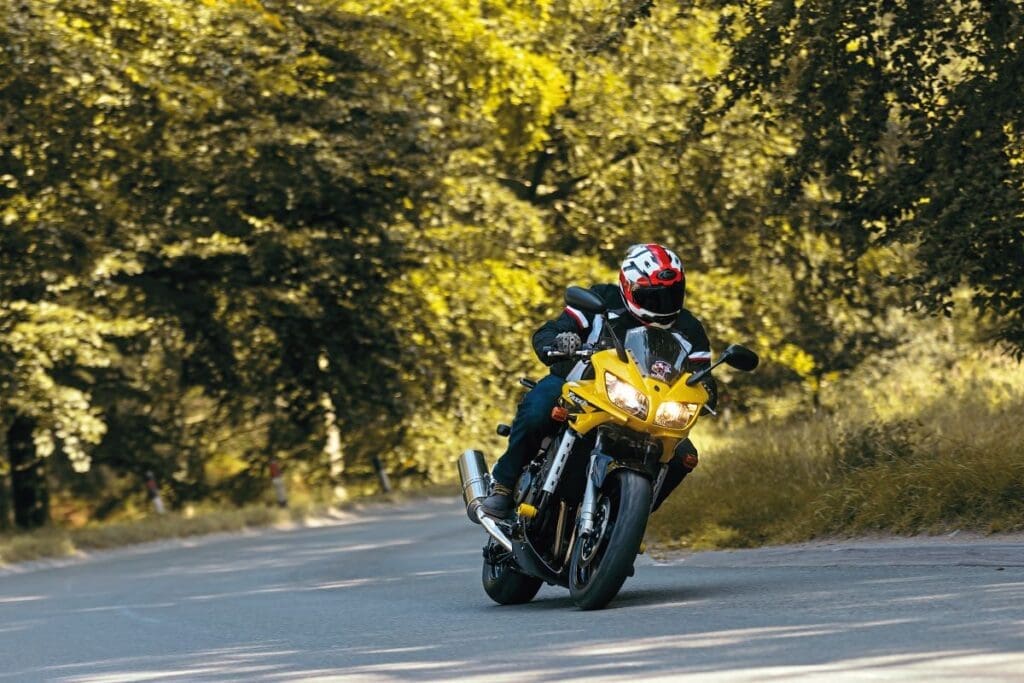
As said, this is a 2003 bike – by which time the frame and swingarm were painted black instead of the previous model’s silver paint. The yellow bike also featured a black engine; the other two colour schemes from 2003 kept the silver engine.
This bike has covered less than 10k miles and is about as good as you will get a 20-year-old bike to be. It is standard, other than a rear hugger, belly-pan, Rentec back rail and crash bungs being added to it. You don’t see many badly modified Fazers which make it a safe bet buying one today as, probably, the most popular mods are different screens for better weather protection and maybe a Scottoiler. Another thing which is apparently worth doing is an ‘Ivan’s Jet Kit’. This jetting kit ditches the overall compromise of the factory carb settings on the Mikuni side-draft CVs to give optimum performance at all revs and throttle openings.
Looking around the bike, it is clear to me to see why Yamaha put the price tag as high as they did when they released the Fazer as the build quality is up there with the VFR800 and Blackbird of the same era. The paint has a gloriously deep pearl finish to it and is really popping in the sunshine as I move the bike around for Gary’s pictures.
Of course, it is a pre-fuel-injected bike, so firing it up requires a little choke to start with, but that 20-valve masterpiece soon settles into an unassisted idle. Out on the road, throttle response even from cold is smooth and linear without glitches or hesitancy. I found the bike easy to manage around town and it was happy pottering around at 30mph in built-up areas and it hides its 208 kilos well. That flexible motor is happy to pull from 40mph in top gear; even 30mph if you don’t grab a handful of throttle – and that’s without any coughs or splutters. Even the mirrors actually work. On most bikes you get to see your elbows, but the Fazer actually has mirrors that show what’s going on behind you – what a radical idea, eh? The 21-litre fuel tank will also give you over 200 miles’ range at reasonable cruising speeds and luckily it has the comfort to match the range.
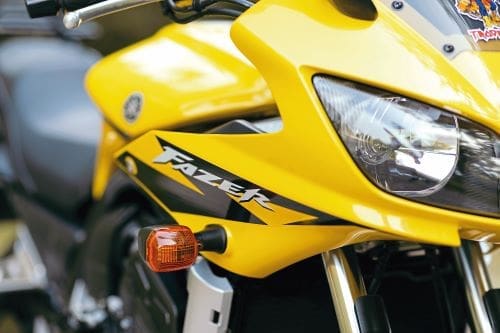


As I mentioned before, that bikini fairing and screen do a remarkable job of keeping the wind blast off the rider at legal speeds. However, anything over 65-70mph cruising and you would benefit from a slightly taller screen, especially if you are around the six-foot mark, as you will be copping the wind blast right in the noggin.
Now, before I tried the bike properly on the A and B roads I altered the suspension settings as the rear was softer than standard and the front was on the standard setting, and to be honest everything felt soft and squidgy for want of a better word, so out with the flat-bladed screwdriver and C-spanner.
I set everything at maximum, then wound everything other than the rear spring pre-load back one click. What a difference this made. Of course, there’s still some room for improvement but adjusting the shock and forks cost nothing other than half-an-hour’s worth of twiddling. Suddenly the Fazer is a lot more composed and isn’t squatting as bad under hard acceleration and can hold a tight-ish line. It’s never going to change direction like an R1 due to its 1450mm wheelbase, but on the other hand it won’t be half as twitchy as the R1 either! So now we can make progress without the bike trying to despatch me into the scenery.
So what is a Fazer 1000 really like to ride? Well, it’s very quick and when you keep the motor spinning around the red-line line, it makes my Bandit 1200 feel a little wanting power-wise, especially the higher up the rev-range you go. Drive out of slower corners is great as you can surf on the big dollop of torque the ex-R1 motor gives you at around 7000 revs and then it keeps on pulling till you have to hook the next gear. Thankfully, both the clutch and gearbox are excellent and give no issues.
The lumps and bumps of Uttoxeter’s back lanes seem to be promoting accidental one-wheel antics and a huge grin. I can’t believe how versatile this bike is: a couple of days ago it was bumbling through town traffic and 30mph speed limits without any fuss whatsoever and today it has turned into a hooligan machine.
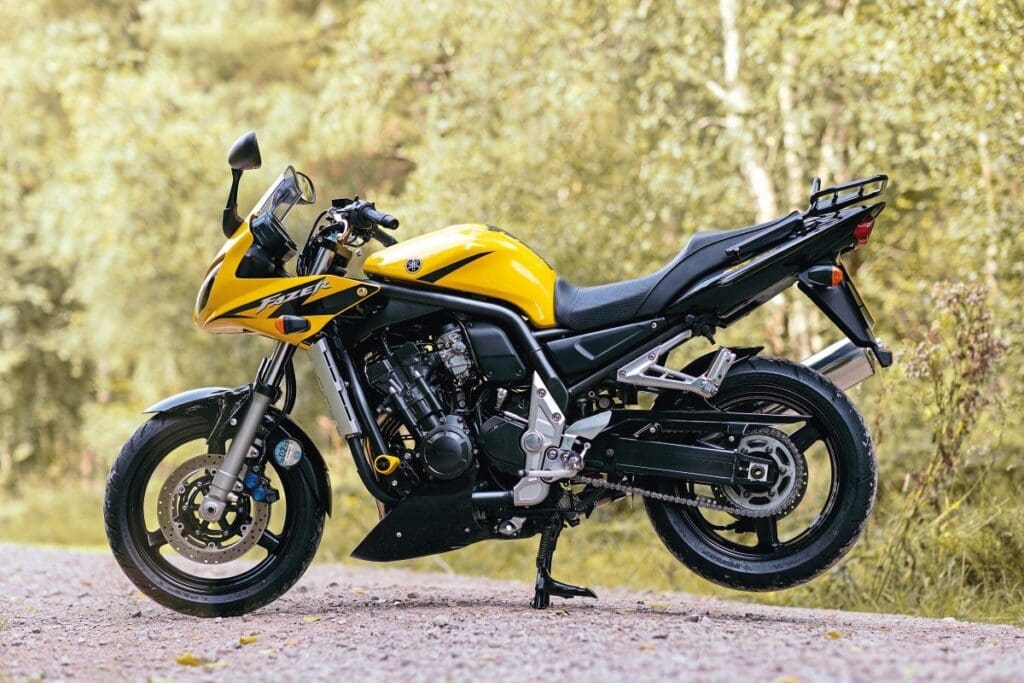
Now, another great plus to this bike is it doesn’t scream for unwanted attention. The standard exhaust is huge, yes, but it keeps the Fazer so quiet that you don’t have to worry about Mr. Plod hearing you from three villages away, giving him time to set up his radar gun ready to zap you. Overall, I just love it; it manages to do everything you could want from a motorcycle and it’s comfy, too. I quite like Bertie’s idea of sticking some top-notch suspension on one and blasting around on track days on one.
So do you fancy one? Well, if you do you’re in luck as there are plenty of good ones about for sale. Don’t let high miles put you off as these things last well and I have seen a couple in a friend’s shop for general servicing with over 60k miles on the clock. Not much seems to go wrong with them. Some bikes use oil but that’s a regular with most of the five-valve Yamaha motors and apparently has a lot to do with how they have been run-in when new. Again this isn’t really a worry as long as you are aware and keep the oil topped up. The EXUP valve will stick if not maintained correctly and if completely neglected will seize, so this needs regular stripping and greasing.
Apparently some 2001-2002 bikes suffered with dodgy wheel bearings (apparently blamed on a bad batch of bearings) but I would expect these to have been replaced by now. Other than the above it’s just general issues. The Fazer 1000’s finish is far more robust even than its smaller 600 sibling and doesn’t seem to attract owners that neglect them or abuse them to the extreme.
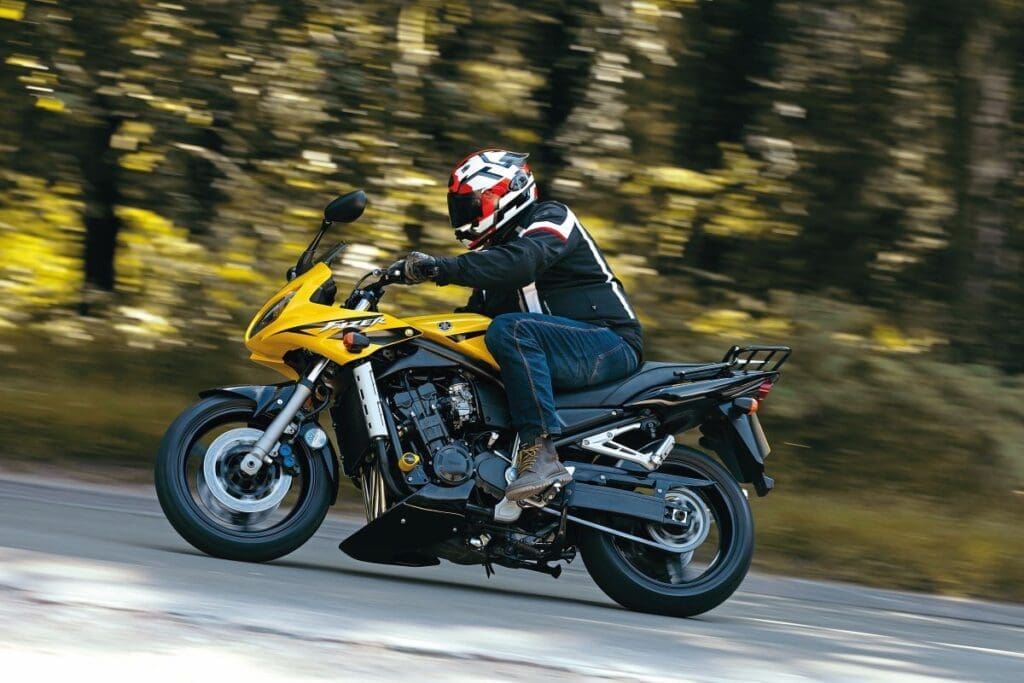
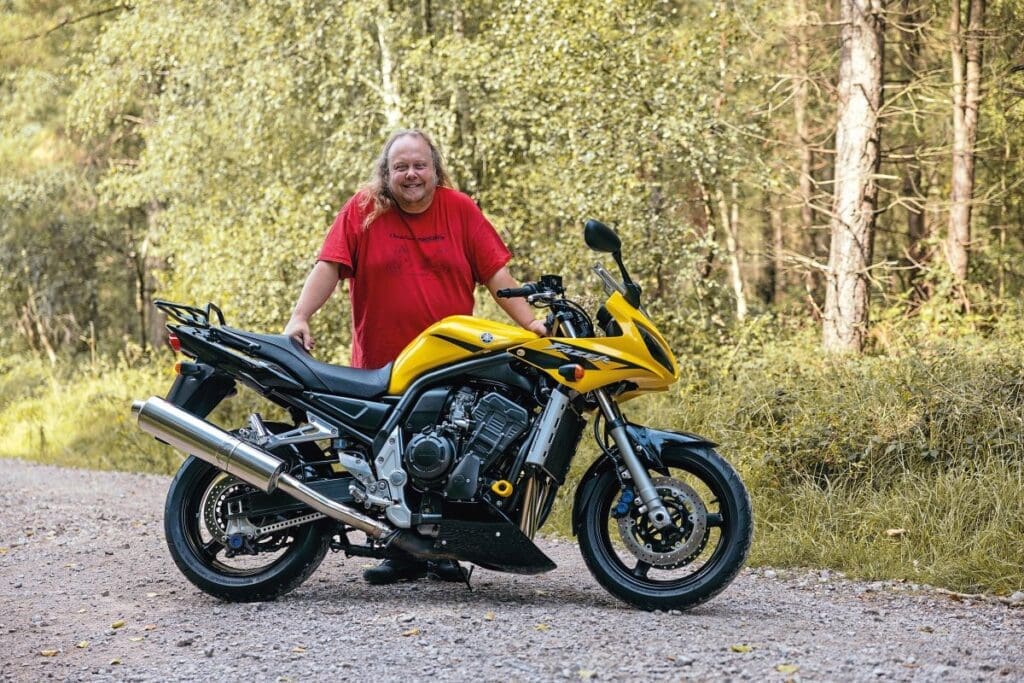
Prices vary from around £2000 for a high-mileage bike with decent history to around the late £3000s for something like our test bike. I have even seen a 2001 bike with luggage and other extras showing 12k miles for £4500. I don’t know if it sold for this but the ad was pulled early so who knows?
To be honest I think the only extras that would add any value to the price of a Fazer would be either full luggage or some flash suspension properly set up. The Fazer ran from 2001-2005 with little or no real changes to it and was then replaced by the fuel-injected FZ1 which was a whole new kettle of fish– but we rather like the original, thank you very much…
Bert’s second opinion…
I’ve gone on record as saying the following: ‘The FZS1000 Fazer isn’t a patch on its little brother…’ I’m now reappraising that comment after this ride. I love this bike.
I’m a fully paid-up fan of the Fazer 600: in fact, in 2000 it became the only brand-new bike I ever bought with my own money. I loved it; I commuted on it; I toured on it; and track-dayed it. My buying decision was made when I left the bike industry in a huff to do PR for Cosworth (cars are boring, I lasted all of nine months) but I had to buy a bike since the ‘free ones’ were going to dry up.
I was leaving Bike Magazine as Road Test Editor so I’d ridden everything and the Fazer 600 was, for me, the only ‘do-it-all’ choice. Fast-forward a year-and-a-bit and I’m back in the bike magazine business and eagerly awaiting the arrival of the Fazer 1000 – surely it’s going to be all that the 600 is, but more!
But for some reason back then, it wasn’t. Or didn’t feel like it was. Maybe it was a case of riding it as a ‘new’ bike and realising the opposition was much cheaper (see other boxout.) Today it’s more of a bargain and even riding it back-to-back with my beloved Honda CBR1100XX Super Blackbird, I thought: ‘Oooh I’d like one of these…’
Perhaps it’s an age thing, but the Fazer 1000 is super-comfy. Perfect padding on the perch; not too much of a reach to those bars (didn’t realise Andy had changed his – I’ve recently done the same on a Kawasaki Versys); and the pegs aren’t high at all. Best of all, the cockpit has a simple, yet pleasing layout (which reflects the early Noughties), and the big mirrors show you plenty of what’s in the rear.
And then there’s that motor: bloomin’ hell it’s got some grunt and top-end. Plenty of character, too – which a pipe or end-can could properly unleash. Those blue-spot brakes are as good as I recall, too, but they still show up the pretty damn soft suspension. I really enjoyed my day riding the Fazer 1000, and I can see why CMM contributor Malc Shaw loved his. I can’t get out of my head the thought of a tricked-up version for the track. But I wouldn’t want one in yellow – too garish! Butch black or rich red for me…
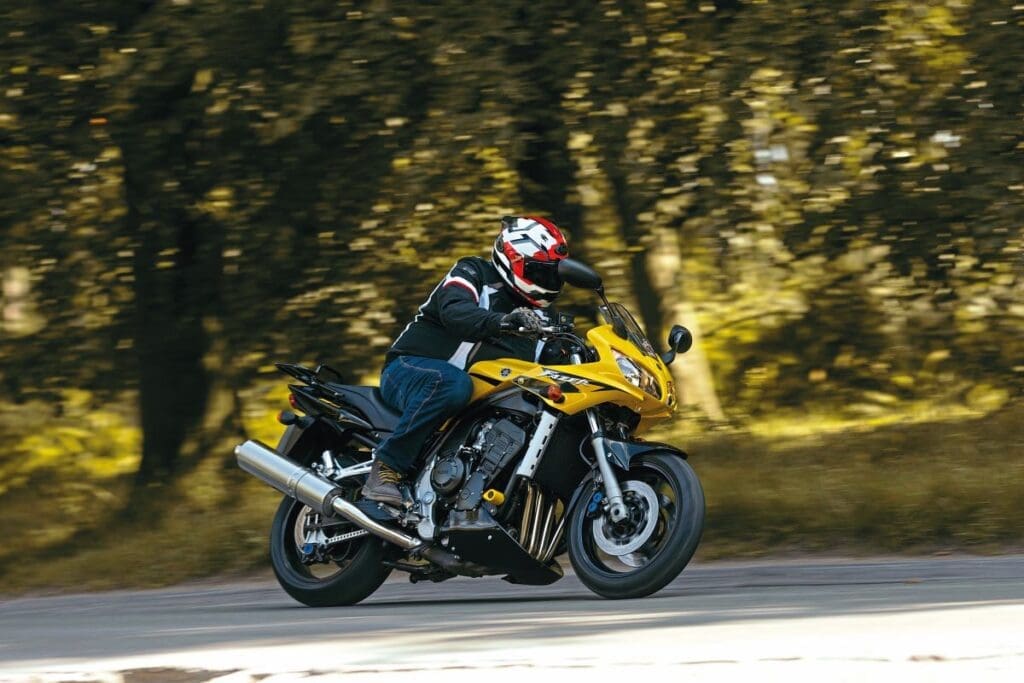
SPECIFICATION
Engine type: 998cc liquid-cooled four stroke DOHC inline four with 5 valves per cylinder
Max power: 143bhp @ 10,000rpm
Max torque: 78lb/ft @ 7500rpm
Transmission: 6-speed
Final drive: Chain
Suspension
Front: 43mm RWU forks adjustable for pre-load, damping and rebound
Rear: Mono shock adjustable for pre-load damping and rebound
Brakes
Front: Twin 298mm disc with four piston calipers
Rear: 267mm disc with twin piston caliper
Tyres
Front: 120-70-17
Rear: 180-55-17
Seat height: 820mm
Wheel base: 1450mm
Dry weight: 208kg
Fuel capacity: 21 litres



